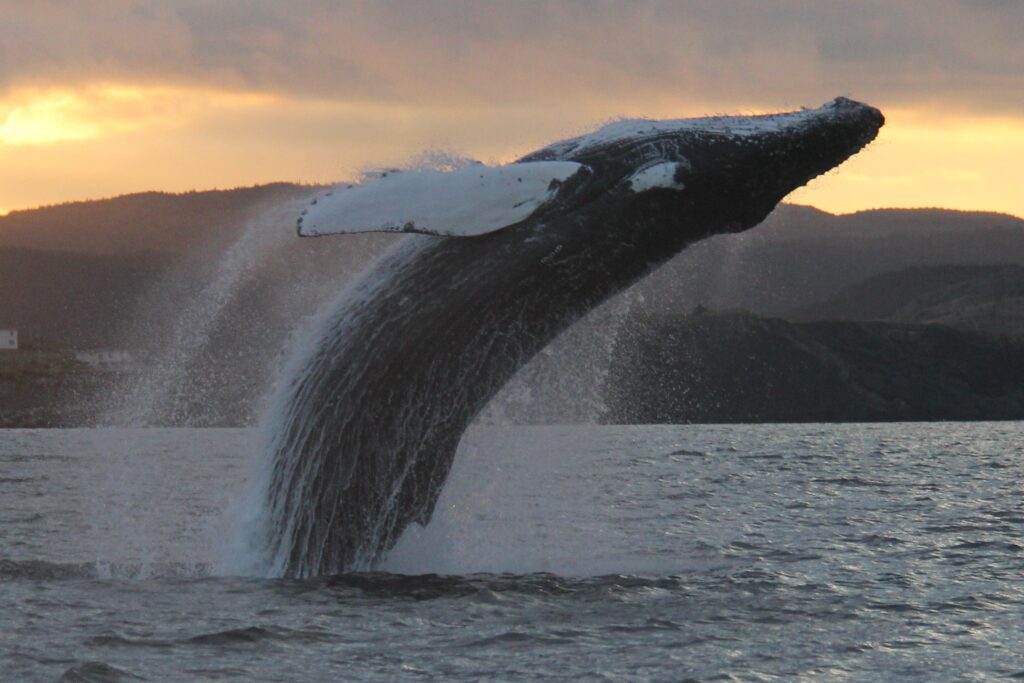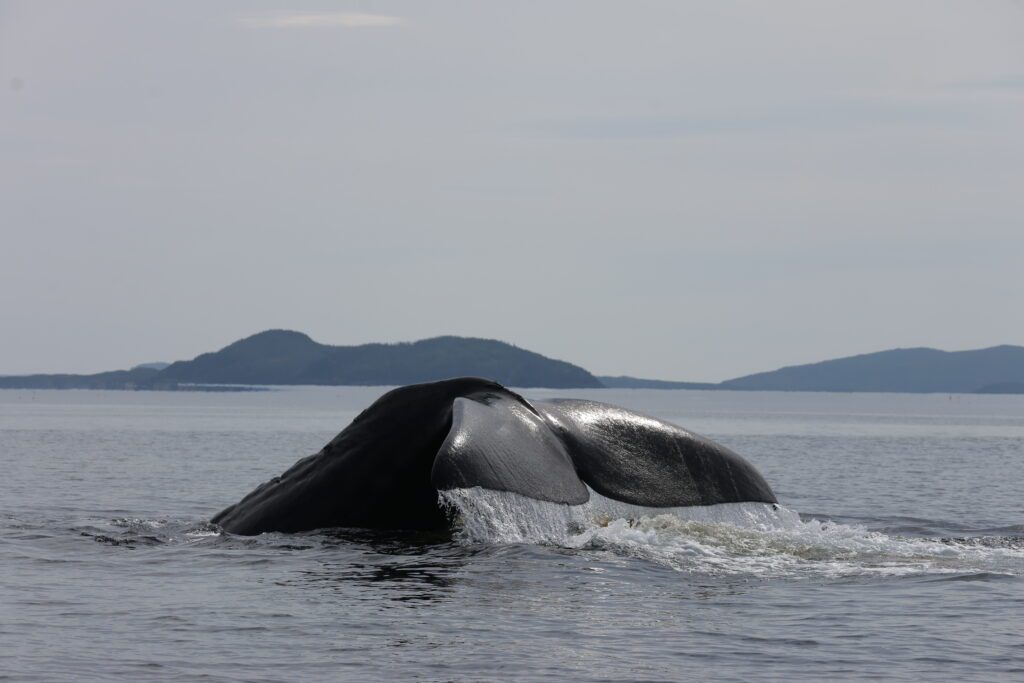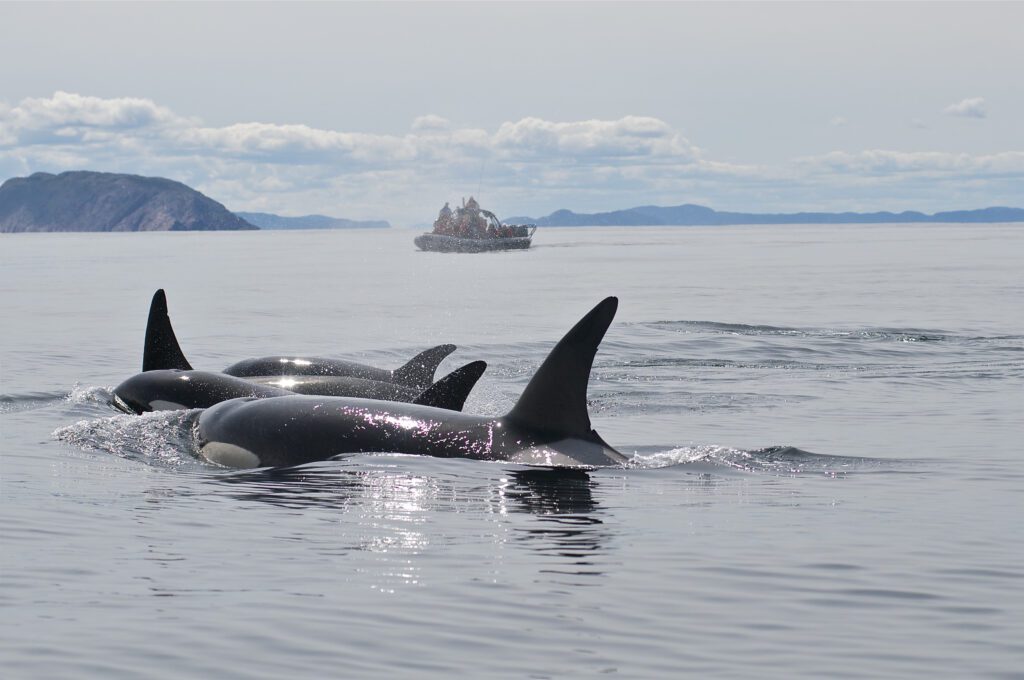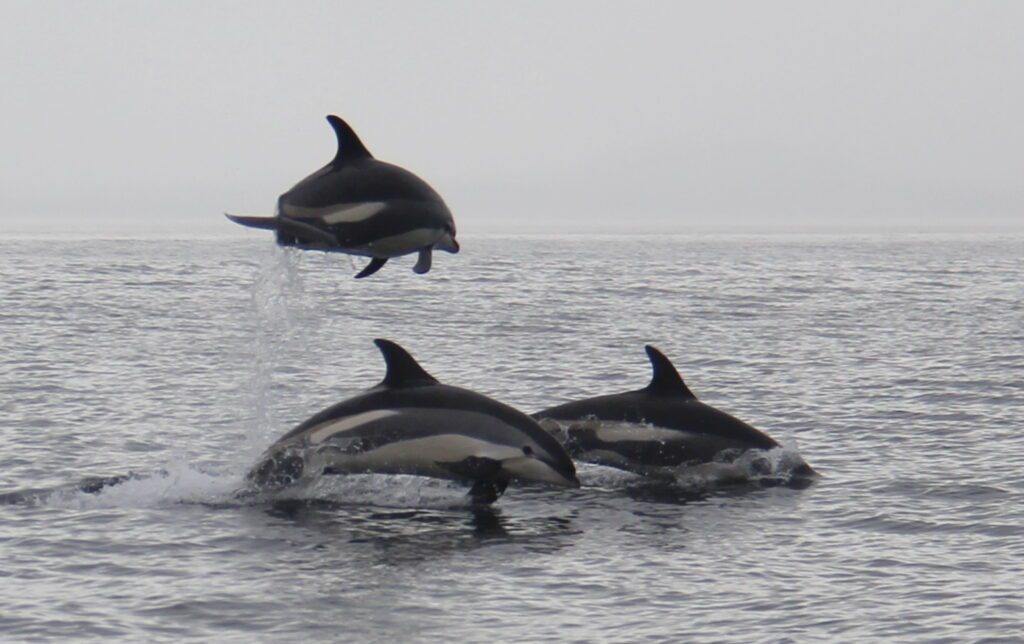Which kinds of whales can I see in Newfoundland?
Many people ask which types of whales you can see in Newfoundland. Here’s the low down on what you might expect to see!
There are two types of whales you can see in Newfoundland: baleen whales and toothed whales.
1. Baleen whales
Baleen whales, as their name suggests, have baleen plates in their mouths instead of teeth. These baleen plates can be as long as 2 meters in some species! Baleen plates act like a sieve in the mouths of these animals. When feeding, these animals take in a mouthful of water and fish, then press their against their baleen to filter out the water and swallow the fish. Whales that have baleen are the largest animals on Earth. The baleen whales that frequent Newfoundland waters include fin whales, sei whales, humpback whales, and minke whales.
Fin whales
Fin whales are the second largest animals on Earth! They are second largest only by 10 feet! They range in size from 60-90 feet long and weigh roughly ½ to 1 tonne per foot. These whales are known as the grey hounds of the sea, they are streamlined and fast. Not much is known about their migratory patterns, or breeding and calving grounds, but we do know that they come here to feed. Fin whales in this region are often spotted in groups of 2-7. Often you will see dolphins travelling with and feeding with fin whales. Fin whales can be identified by their white right jaw and white chevron that goes up and over their back. They also have a small dorsal fin that may be angled backward and hooked.
Sei whales
Sei whales are very similar in size and shape as fin whales and are often confused for them. These whales spend more of their time in the deep ocean offshore so are not as common as fin whales. They do come in occasionally. Their dorsal fins tend to be a little more upright than a fin whale’s. These whales also do not have the white lower jaw on their right hand side. Surfacing behaviour is different in sei whales than fin whales – A fin whale’s blow hole will appear, then go below the surface and its dorsal fin will come up. When sei whale surfaces, the blow hole and dorsal fin are on the surface at the same time.

Humpback whales
Humpback whale are the acrobats of this group. They are famous for behaviours such as flipper slapping, tail lobbing, spy hopping and breaching. They are easily distinguished from other whales because of the bump before their dorsal fin (the hump) and because they hump their backs when they dive and bring out their tails. The humpbacks’ scientific name, Megaptera novaengliae, big winged New Englander, is a nod to its 9-11 foot pectoral fins which are much larger than any other species. Humpback whales measure 30-50 feet in length and weigh about one tonne per foot.
Humpback whales are one of the species with which we do photo identification research with here at Sea Of Whales Adventures. The tails of these animals are each as unique as a human fingerprint and, when photographed, can allow matches within the Sea of Whales catalogue or with other research organizations across the globe. (Stay tuned for more on this in an upcoming post about whale identification.)
Minke whales
Minke whales are the smallest and fastest of all of the baleen whales. These little whales are characterized by the white band on their pectoral fins and their small sickle back dorsal fin. Minkes are fast and can turn on a dime, usually feeding alone. Though it is not common, we do sometimes see Minke whales do breaches. These whales are often the target of Orcas when they visit our area.
2. Toothed Whales
Sperm whales
Sperm whales are found in our region. This is unexpected as they generally live off of the continental shelf or around volcanic islands where the water is very deep. However, both Trinity and Bonavista Bay

have very deep trenches where depth measure as much as 1900 feet! We use our hydrophones to listen to the echolocation clicks of sperm whales on as many trips as possible. The animals in this area are males who come to northern waters to feed while females stay in more temperate water.
As with all toothed whales, there is a large difference in size between males and females. In this species,
females are about one third smaller than male sperm whales. These animals are characterized by their large square heads and single blow hole, which is on the front left side of their head. The skin may appear wrinkled and their bodies are very thick. They are 50-60 feet long and weigh 40-50 tonnes. When they dive deep, sperm whales bring their tails high out of the water. Tail shape is unique to each individual and photo identification records are kept of this species by Sea of Whales Adventures as well.
Orcas
Orcas, though often referred to as whales, are actually the largest of all of the species of dolphins. Characterized by their distinct black and white colouring and pronounced dorsal fins, these whales are well know world wide. They can grow up to 15-30 feet long and weight up to 9 tonnes.
When Orcas will arrive and how long they will stay is never known in Newfoundland, though it is certainly a treat to see them any time that they do. When spotted in Newfoundland water, these animals are often feeding on other whales including minkes and the calves of other larger species. Many of our humpback whales bear scars on their tails from Orca attacks when they were young. Sea of Whales Adventures contributes to the North Atlantic Orca catalogue and has made several matches over the years.

Pilot whales
Long finned pilot whales typically arrive with the squid, in late summer and fall. They are typically in larger groups than other whales in our region. These animals have dorsal fins that are quite wide at the base, and are angled back and rounded. They have a bulbous head and long skinny pectoral fins. Pilot whales can grow up to 12-20 feet long and weigh 2-3 tonnes.
Dolphins
White sided dolphins are often seen around other species of whales including humpback whales, fin whales and long finned pilot whales. They grow 6-8 feet long and weigh 350-450 pounds. They are characterized by the black, white, and grey stripes along their sides with a tan or yellow patch on their tail stock. These dolphins like to ride bow waves and wakes of boats and sometimes leap out of the water though not as often as the white beaked dolphins.

White beaked dolphins are often mistaken for white sided dolphins, but are typically bigger and coloured a little differently. These animals grow to lengths of 8-10 feet and weigh up to 600 pounds and lack the yellow or tan patch that their white sided cousins have. These dolphins often breach and ride bow waves of fast moving boats.
Harbour porpoises are the smallest of all of the cetaceans seen in Newfoundland waters. Reaching lengths of just 4-6 feet and weighing in at 100-150 pounds. These little creature are typically very hard to see. Not much of them comes out of the water and they are so small that what does come out is not easily seen unless the sea is very calm and they come quite close. They are characterized by their smaller size than the other dolphins in our area, as well as the distinct triangular dorsal fin.
There are so many different types of whales you can see in Newfoundland! Book your tour today and get ready for an adventure you’ll never forget!
This entry was posted in Sea of Whales Blog by Sea Of Whales Adventures. Bookmark the permalink.
